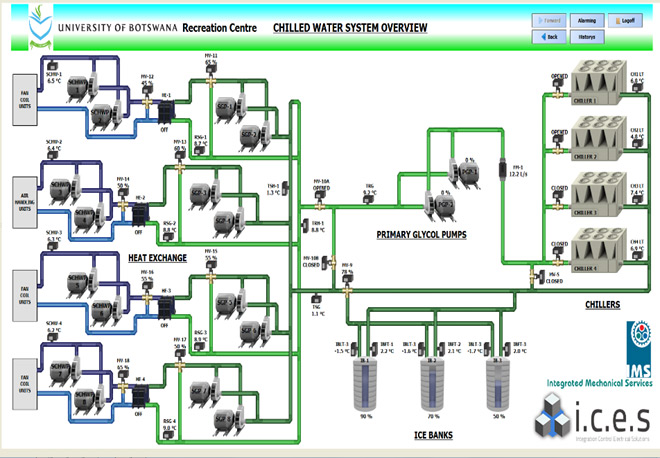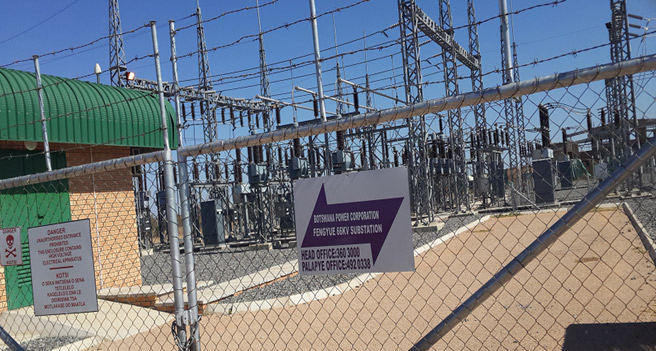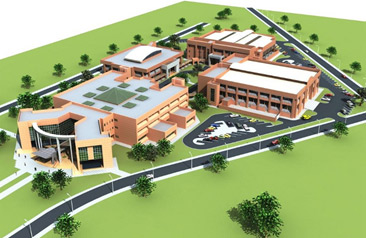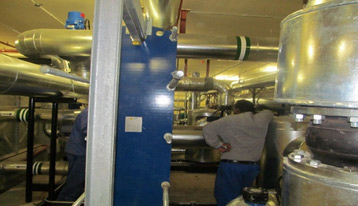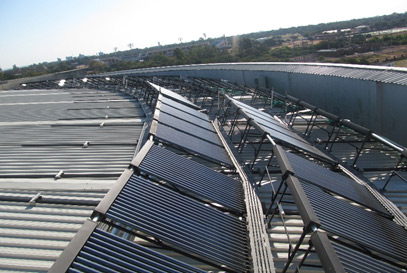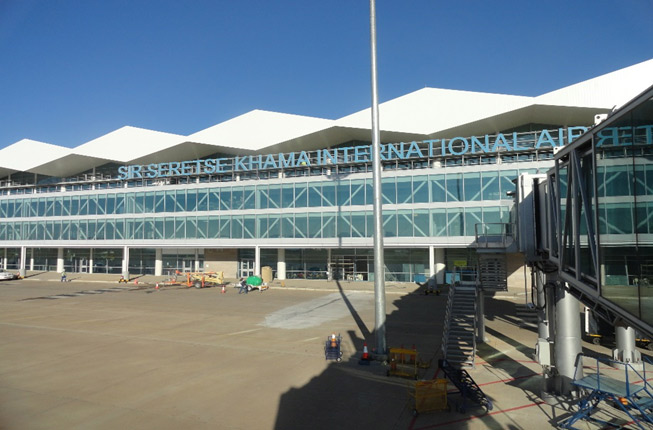Project Details
Client : University of Botswana
Cost of Works : BWP 286, 000, 000.00
Date of Completion : 30th April 2015
Project Description
 The Campus Recreation Centre is a landmark structure
The Campus Recreation Centre is a landmark structure
within the University of Botswana which comprises of a Main Arena, Fitness Training Area, Martial Arts, Aerobic Studio, Squash Courts, Seminar Rooms, Students committee room, Chancellors’ and VIP Lounges, Press room, Computer lab, Classrooms, Administration Offices and other ancillary spaces.
The total floor area of all storeys is 19, 160m2 including parking space which comprise of 170 parking lots. The building also comprise of a sub-basement for mechanical plant and furniture store, plant rooms at fourth floor to house hot water calorifiers, chillers and domestic water tank.
The Main Arena, which is a triple volume space, was designed to accommodate 6, 000 people at full capacity and is used for official congregations, graduation convocations, large conferences, various sporting activities like volley ball and netball.
The Main Arena usually run at full capacity for 4 to 8 hours on each instance unless there is a music show which can go beyond 8 hours.
The building is a green building and therefore was designed in line with LEED-NC Application Guide for Multiple Buildings and On-Campus Building Projects
Design Response and Philosophy
The client, The University of Botswana was given a chance to
participate in the design choices. To take advantage of the load pattern of the Main Arena, Seminar rooms, Classrooms, Chancellors and VIP Lounges, G4 Mechanical Engineers used thermal storage air conditioning system, which is ideal for sporadic nature of usage of the facility where the maximum load only occurs for a short duration with a long time between loads.
The installation comprised a chilled water system comprising four glycol chillers with a total cooling load of 3, 000 Watts, three ice storage tanks with ice storage capacity of 8, 327 kWh each, circulation pumps, heat exchangers, four air handling units for the Main Arena, as well as fan coil units for the other ancillary spaces.
The air conditioning plant for the Main Arena was located at roof level. In view of the triple volume arrangement of the Main Arena, G4 Mechanical Engineers considered the question of effective supply of conditioned air into the occupied spaces and to reach the occupancies. This was achieved by using radial long jet nozzles capable of supplying large volumes of air and are suitable for mounting heights of up to 37m. The air handling units were provided with insulated ducts complete with attenuators to achieve indoor noise levels not exceeding NR35.
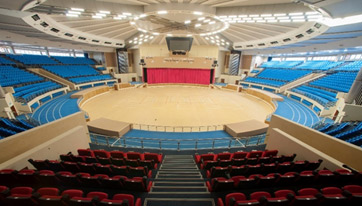 Most of the spaces within the building were designed to achieve internal conditions of 230C, 50% relative humidity in summer and 200C, 40% relative humidity in winter. However the Main Arena because of its capacity was designed to have 230C, 50% relative humidity in summer and in winter comfort conditions shall be maintained by latent gains from people and heat generated from high levels of lighting. In winter we also provided free cooling through motorized dampers as a way to save energy.
Most of the spaces within the building were designed to achieve internal conditions of 230C, 50% relative humidity in summer and 200C, 40% relative humidity in winter. However the Main Arena because of its capacity was designed to have 230C, 50% relative humidity in summer and in winter comfort conditions shall be maintained by latent gains from people and heat generated from high levels of lighting. In winter we also provided free cooling through motorized dampers as a way to save energy.
Thermal Modelling for Reduction in Energy Consumption
The Application Guide provides an opportunity for building owners to reduce the environmental impact of buildings by approaching green buildings within the campus in a broader context. The guide will help in the interpretation of credits with respect to Sustainable Sites, Water Efficiency, Energy, Atmosphere, Materials and Resources and Indoor Environmental Quality.
The selection of proper glazing material, roof insulation and solar shading to achieve optimum thermal performance was made easier with the use of the Application Guide.
The whole exercise involved the client, architects and engineers to study the heat gains through the building orientation, optimum building materials and glazing to reduce heat gains and air conditioning energy consumption.
Optimal Selection of Air Conditioning Plant
The Campus Recreation Centre is a facility where full load is only required for short periods of time hence it was ideal for us to propose glycol chillers and ice tanks. This choice suited the sporadic nature of the building and drastically reduces the energy use during the day because chillers will only run at night when temperatures will be low.
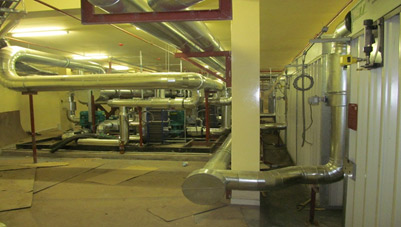 The use of thermal storage air conditioning system in the form of precinct cooling plant, which because of its energy saving and sustainable nature is considered a “green” technology under LEED rating system.
The use of thermal storage air conditioning system in the form of precinct cooling plant, which because of its energy saving and sustainable nature is considered a “green” technology under LEED rating system.
Peak Energy Demand Reduction
Peak cooling demands occurs between 14h00 to 16h00. During this time of the day the system will only run with circulation pumps heat exchangers making use of ice stored during the night. This reduces the energy required to run the plant. Chillers are only required to run during the night between 10 to 12 hours to form ice that will be used the following day.
Low energy consumptions, chillers will run at night during off peak hours when electricity tariffs are low. Low energy consumption equates to low emissions and reduced environmental impact.
Indoor Environmental Quality
To maintain indoor air quality we provided fresh air to all occupied spaces at a rate of 7.5l/s. AHUs for the Main Arena due to free cooling concept also used 15% fresh air.
Refrigerant/Gaseous Ozone Depleting Potential (ODP)
Our choice of chillers on the Campus Recreation Centre was use of chillers that use R134a refrigerant, which is a modern refrigerant and has not had any phased out controls yet according to the Montreal Protocol. The R134a refrigerant has zero ozone depletion potential and very low warming potential.
Fire Strategy
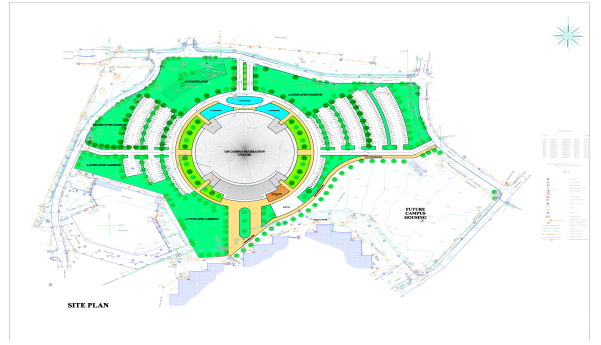
Key characteristics taken into consideration in design of fire strategy for the Campus Recreation Centre were the following;-
- High occupancy capacity
- Potential for high loss of life
- Large volumes and long travel distances
- Possibilities of disorientation, resulting from complex layouts.
In our designs for fire strategy we prioritized the following;- life safety, property protection and continuity of building operations. The Building has a total of eight emergency exits which can be used to evacuate occupancy from the fully capacity facility in less than 25 minutes.
 |
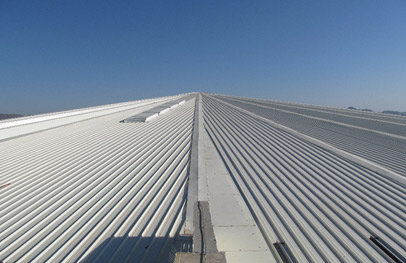 |
To complement the evacuation process we made sure plant is located far away from exit routes when fire breaks out.
Over and above we provided Automatic Sprinkler Installation, Staircase Pressurization, and Smoke Extraction System
Life is normally lost due to inhalation of smoke from burning material therefore we provided automatic smoke ventilation louvres at the apex of the roof leading from the four cores of the building.
Domestic Water Heating
The nature of the indoor sporting facility requires substantial amounts of hot water in change rooms for the athletes. Therefore it was very important for us to come up with an installation that would save the client energy in providing hot water. We therefore decided to install Solar Water Heating (renewable source) to supplement electrical heating for the provision of hot water for use in Change rooms, Chancellors’ and VIP toilets. The installation provided comprises of indirect type with the thermal exchange between the solar heating element (vacuum tubes with heat pipe) and the water taking place in the solar collector header.
Building Management System (BMS)
Due to the complexity of the installation, distances between services and operating time schedules of some of the equipment like ice making mode (which takes place at night), we found it ideal to have a fully Building Management System for the day to day operations of the plant. The system is based on Distech Controls Equipment. The software solutions are based on Java Application called Niagara framework, which is web enabled solution establishing a fully internet-enabled, distributed architecture for real time access automation and control of devices. The client can operate and monitor the system from the comfort of their homes though checks will be required on site from time to time.
